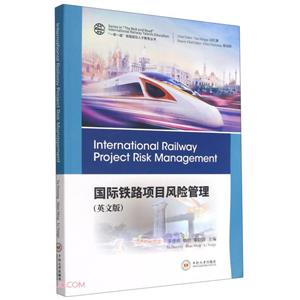中圖網小程序
一鍵登錄
更方便
本類五星書更多>
-
>
公路車寶典(ZINN的公路車維修與保養秘籍)
-
>
晶體管電路設計(下)
-
>
基于個性化設計策略的智能交通系統關鍵技術
-
>
花樣百出:貴州少數民族圖案填色
-
>
山東教育出版社有限公司技術轉移與技術創新歷史叢書中國高等技術教育的蘇化(1949—1961)以北京地區為中心
-
>
鐵路機車概要.交流傳動內燃.電力機車
-
>
利維坦的道德困境:早期現代政治哲學的問題與脈絡
國際鐵路項目風險管理(英文版) 版權信息
- ISBN:9787548743354
- 條形碼:9787548743354 ; 978-7-5487-4335-4
- 裝幀:一般膠版紙
- 冊數:暫無
- 重量:暫無
- 所屬分類:>>
國際鐵路項目風險管理(英文版) 內容簡介
本書論述了我國鐵路工程項目風險管理的現狀與發展展望, 工程保險與工程擔保的發展歷程 ; 系統地闡述了鐵路工程項目風險管理的基本理論和實際操作內容 ; 詳細地介紹了目前工程保險所屬多種險種的條款解釋、承保、理賠和風險評估的全部內容 ; 分析了工程擔保制度的理論基礎, 并介紹了國內外工程擔保實施現狀。
國際鐵路項目風險管理(英文版) 目錄
Chapter 1 Introduction
1.1 Drivers,concepts and characteristics of international projects
1.2 Concepts and key features of construction megaprojects
1.3 International project delivery systems
1.4 Global railway construction markets
1.5 Introduction of risk management
1.6 Channel Tunnel Rail Link risk transfer and innovation in project delivery
Exercises and Discussions
Chapter 2 Risk Management Principles, Frameworks and Processes
2.1 Introduction
2.2 Risk management principles
2.3 Risk management conceptual frameworks
2.4 Risk management process
Exercises and Discussions
Chapter 3 Legal Systems,Contracts, and Legal Risks
3.1 Introduction
3.2 Governing law system
3.3 Different types of legal systems
3.4 Differences between common law system and civil law system
3.5 International engineering and construction contracts
3.6 Legal risks in international railway projects
Exercises and Discussions
Chapter 4 Project Risk Formation Mechanisms
4.1 Construction accident formation mechanisms
4.2 PPP/BOT transportation project failure mechanisms
4.3 International railway project loss mechanisms
4.4 International railway project loss case
Exercises and Discussions
Chapter 5 Risk Identification Techniques
5.1 Introduction
5.2 Assumptions and constraints analysis
5.3 Scenario analysis
5.4 Flow diagram
5.5 SWOT Analysis
5.6 Cause and effect diagrams
5.7 Checklists
Exercises and Discussions
Chapter 6 Sensitivity Analysis, Bayesian Analysis and Decision Tree Analysis
6.1 Sensitivity analysis
6.2 Bayesian analysis
6.3 Decision tree analysis
Exercises and Discussions
Chapter 7 Preliminary Hazard Analysis, Influence diagrams technique and Z-Matrix
7.1 Preliminary hazard analysis
7.2 Influence diagrams
7.3 Z-Matrix
Exercises and Discussions
Chapter 8 Event Tree Analysis and Fault Tree Analysis
8.1 Introduction
8.2 Event tree analysis
8.3 Fault tree analysis
Exercises and Discussions
Chapter 9 Monte Carlo Simulation
9.1 Commonly used probability distributions in engineering
9.2 Basics of Monte Carlo simulation
9.3 Generation of random numbers
9.4 CDF-inverse method (continuous case)
9.5 Acceptance-rejection method
9.6 Generation random variates from probability distributions
9.7 Variance-reduction techniques
9.8 Monte Carlo simulation case
Exercises and Discussions
Chapter 10 System dynamics
10.1 Historical overview of the system dynamics approach
10.2 Causal loop diagrams and stock and flow diagrams
10.3 Procedures for using the system dynamics method
10.4 Application case of system dynamics
Exercises and Discussions
Chapter 11 Project Risk Early Earning
11.1 Introduction
11.2 Earned-value-management-based project schedule and cost early warning
11.3 Earned-schedule-based project schedule early warning
11.4 Dynamic-control threshold-based project schedule early warning
Exercises and Discussions
Chapter 12 Construction Insurance and Surety Bonds
12.1 Introduction
12.2 Insurance for international railway engineering projects
12.3 Surety bonds for international railway engineering projects
Exercises and Discussions
Chapter 13 Variations, Claims and Disputes
13.1 Introduction
13.2 Variations in construction
13.3 Claims in construction
13.4 Disputes in construction
Exercises and Discussions
References
1.1 Drivers,concepts and characteristics of international projects
1.2 Concepts and key features of construction megaprojects
1.3 International project delivery systems
1.4 Global railway construction markets
1.5 Introduction of risk management
1.6 Channel Tunnel Rail Link risk transfer and innovation in project delivery
Exercises and Discussions
Chapter 2 Risk Management Principles, Frameworks and Processes
2.1 Introduction
2.2 Risk management principles
2.3 Risk management conceptual frameworks
2.4 Risk management process
Exercises and Discussions
Chapter 3 Legal Systems,Contracts, and Legal Risks
3.1 Introduction
3.2 Governing law system
3.3 Different types of legal systems
3.4 Differences between common law system and civil law system
3.5 International engineering and construction contracts
3.6 Legal risks in international railway projects
Exercises and Discussions
Chapter 4 Project Risk Formation Mechanisms
4.1 Construction accident formation mechanisms
4.2 PPP/BOT transportation project failure mechanisms
4.3 International railway project loss mechanisms
4.4 International railway project loss case
Exercises and Discussions
Chapter 5 Risk Identification Techniques
5.1 Introduction
5.2 Assumptions and constraints analysis
5.3 Scenario analysis
5.4 Flow diagram
5.5 SWOT Analysis
5.6 Cause and effect diagrams
5.7 Checklists
Exercises and Discussions
Chapter 6 Sensitivity Analysis, Bayesian Analysis and Decision Tree Analysis
6.1 Sensitivity analysis
6.2 Bayesian analysis
6.3 Decision tree analysis
Exercises and Discussions
Chapter 7 Preliminary Hazard Analysis, Influence diagrams technique and Z-Matrix
7.1 Preliminary hazard analysis
7.2 Influence diagrams
7.3 Z-Matrix
Exercises and Discussions
Chapter 8 Event Tree Analysis and Fault Tree Analysis
8.1 Introduction
8.2 Event tree analysis
8.3 Fault tree analysis
Exercises and Discussions
Chapter 9 Monte Carlo Simulation
9.1 Commonly used probability distributions in engineering
9.2 Basics of Monte Carlo simulation
9.3 Generation of random numbers
9.4 CDF-inverse method (continuous case)
9.5 Acceptance-rejection method
9.6 Generation random variates from probability distributions
9.7 Variance-reduction techniques
9.8 Monte Carlo simulation case
Exercises and Discussions
Chapter 10 System dynamics
10.1 Historical overview of the system dynamics approach
10.2 Causal loop diagrams and stock and flow diagrams
10.3 Procedures for using the system dynamics method
10.4 Application case of system dynamics
Exercises and Discussions
Chapter 11 Project Risk Early Earning
11.1 Introduction
11.2 Earned-value-management-based project schedule and cost early warning
11.3 Earned-schedule-based project schedule early warning
11.4 Dynamic-control threshold-based project schedule early warning
Exercises and Discussions
Chapter 12 Construction Insurance and Surety Bonds
12.1 Introduction
12.2 Insurance for international railway engineering projects
12.3 Surety bonds for international railway engineering projects
Exercises and Discussions
Chapter 13 Variations, Claims and Disputes
13.1 Introduction
13.2 Variations in construction
13.3 Claims in construction
13.4 Disputes in construction
Exercises and Discussions
References
展開全部
書友推薦
- >
山海經
- >
推拿
- >
小考拉的故事-套裝共3冊
- >
月亮與六便士
- >
煙與鏡
- >
人文閱讀與收藏·良友文學叢書:一天的工作
- >
中國歷史的瞬間
- >
巴金-再思錄
本類暢銷















